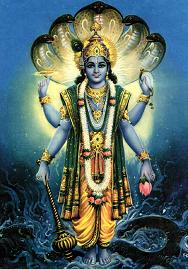 |
Essence Of
Bhavishya Purana
|
| 7 ‘Ganesha Chaturthi Vrata’-Origin, Procedure and Reward | |
Ganesha Chaturthi Vrata scheduled on Bhadrapada Shulka Chaturthi every year is a popular and auspicious function observed in several parts of Bharat by all the members of households and by all Varnas to ensure fulfillment of long standing desires, ‘Vidya’ (education), good health, wealth, longevity and most importantly clearance of obstacles and assurance of success as ‘Vighneswara’ is the Foremost Deity of Sanction to be appeased for the accomplishment of any task to be undertaken not only by human beings but even Devas, Rakshasas and even Trimurthis! Once Ganesha’s younger brother, Kartikeya, was stated to have attempted the scripting of the characteristics of men and women but Ganesha seemed to have frustrated the attempts of Kartikeya who almost did the description of ‘Purusha Lakshanas’ but left the effort concerning the features of women.In fact, Kartikeya felt so angry that he pulled out one of the tusks of Ganesha. When Parameswara intervened and enquired about his own ‘Purusha Lakshanas’, Kartikeya described about Shiva that he was a ‘Kapaali’ and of none-too pleasant a visage, Shiva got irritated and threw away the Script in the Sea. Shiva commanded ‘Samudra’ (the Sea) to complete the Script of the Characteristics of Women and retrieve the Script of Kartikeya about men. Hence the Scripts were named ‘Samudrika Shastra’. Even now, the Idols of Ganesha are presented as holding a part of his tusks with one of his hands! Another context which prompted Shiva to let Brahma authorise Ganesha to become the ‘Gana Nayaka’and ‘Vighna Rajah’ was when even ordinary and often egoistic human beings in Krita Yuga had no bounds and barriers in performing deeds that they were not expected to do; also there was no access to human beings to get bad dreams or omens so that they would realise forewarnings not to indulge in such avoidable activities. This was the reason why human beings had to be aware of warnings of impediments and non-achievements and as such all the beings in Srishti are made to realise perforce that there would never be a ready and unquestioned admittance to the gates of success, without proper propitiation of Vighna Deva.! After comfortably seated on his throne, the Idol of Vighna Rajah is welcomed for initiating worship by the devotees with ‘Snaan’ or bathing with scented waters and ‘Panchamritams’ being the mix of milk, curd, honey, fruit-pulp and coconut water. While performing the ‘Snaan’/‘Abhisheka’, the following ‘Mantra’be recited: Sahasraaksham shata dhaaramrushibhih paavanam kritam, thena twamabhishinchaami paavamaanyaha punantutey/ bhagamtey Varuno raajaa bhagam Suryo Brihapatih, Bhagamindrischa Vaayuscha bhagam Saptarshayo daduh/ yatey Kesheshu dourbhaagyamseemantey yaccha Murdhani, Lalaatey karnayo rakshanoraapastadughnantu tey sadaa/ After the ‘Mantra Snaan’, the devotee should offer palm-ful of flowers by reciting the Mantra: Rupam dehi yasho dehi bhagam Bhagavati dehi mey, Putraan dehi dhanam dehi Sarvaan Kaamaamscha dehi mey, Achalaam Buddhim mey dehi Dharaayaam Khyatimevacha / (Hey Bhagavati, Kindly bestow to us attractive appearance, reputation, vivacity, ideal progeny, prosperity and fulfillment of all our desires; do grant me steady intellect and status in life!). Following formal worship to Ganesha, his Wives Buddhi (Wisdom) and Siddhi (Accompishment), Shiva, Devi Parvati, Devi Lakshmi, Surya, Kartikeya, and other Devas, Brahmanas are satisfied with Bhojan, Vastras, Dakshinas and Gifts. While Ganesh Puja is performed on Bhadrapada Shukla Chaturthi regularly, there is basically no specific time of Tithi, Nakshatra and Maasa restraints. Like performing Devi Gayatri Mantra daily, Ganesha Gayatri too could be a daily recited Mantra, viz. Mahakarnaaya vidmahey Vakratundaaya dheemahi tanno Dantih prachodayaat; in fact worship of Vighneswara is a ‘must’ before any ‘Puja’ as prescribed in Vedic faith. Specifically speaking however, Chaturthi in Bhadrapada Shukla Paksha has added significance since that day happens to be an auspicious day for Shiva worship too. That is also the day of devotion to a married woman’s parents-in-law to achieve ‘Sowbhagyata’ or longevity of her husband and propitiousness to all the members of the family, since Puja on that day has the double advantage of Shiva and Ganesha. Further, worship on any Shukla Chaturthi coinciding with Bhoumavara (Tuesday) bestows contentment and pleasure, besides ‘Soundaryata’ (beauty and grace) to women, since that day signifies the Mangala Deva-the ‘Tejas’ of Shiva and Parvati transferred to Bhu Devi- who wears blood-red Vastras and of fiery nature- also popular as Kuja, Rakta, Veera and Angaraka. | |
 Prev:‘Vratas’ on ‘Pratipada’, ‘Dwiteeya’ and ‘Triteeya’ ‘Tithis’ Prev:‘Vratas’ on ‘Pratipada’, ‘Dwiteeya’ and ‘Triteeya’ ‘Tithis’ | |
 Next:‘Vratas’ on ‘Pratipada’, ‘Dwiteeya’ and ‘Triteeya’ ‘Tithis’
Next:‘Vratas’ on ‘Pratipada’, ‘Dwiteeya’ and ‘Triteeya’ ‘Tithis’